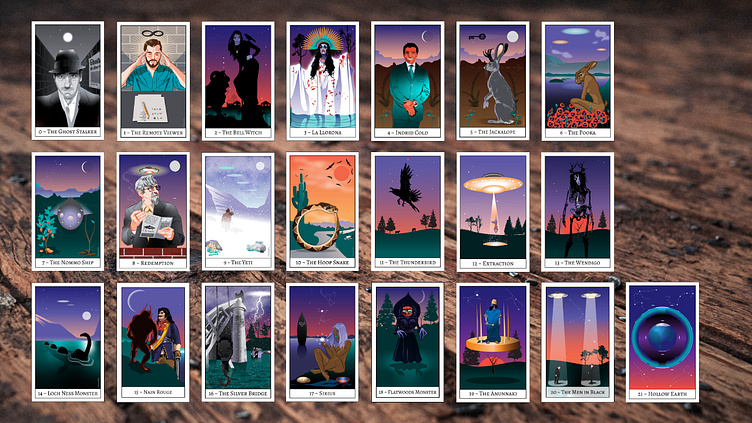What goes into designing a tarot deck?
In February 2022, decided to create my own, original tarot deck.
I wanted to make a deck based on cryptids, UFOs, the paranormal, and other Fortean weirdness. I truly had no idea what I was getting into. I had a deep familiarity with tarot decks as I collect them for the artwork (and a few I actually read with). Here's what I didn't consider.
So much research. So much coffee.
Tarot collectors and readers expect several things from a deck and one is that you did your homework. This isn't just slapping down any drawings you want until you fill up a deck.
You have to do a lot of research and reading to understand what the decks mean. Now, I've been reading tarot cards for 30+ years and when it came to making a deck, I felt like a newb. Why? I knew the meanings, inside and out. What I hadn't learned was the symbolism.
For example, let's say you decided to make a deck based on the American Southwest. You need to know your rock formations, local flora and fauna. This seems obvious until you realize that you now need to go back and find out which of those animals, plants, rocks and minerals are relevant to the cards.
Coyotes have long been associated with tricksters. If you used a coyote to represent say, the Queen of Cups (a card of pregnancy) what are you saying? That the pregnancy is a hoax? A false pregnancy? I hope that extreme example drives the point home.
How I got in trouble with a nation over this.
I had a card in my deck that I loved, and was told to remove it. Immediately. I thought I had done my research. I wanted one card to be a shapeshifter card, so I chose the Skinwalker. I had been posting my cards to my Instagram account as I finished each one. It was a great way to keep motivated and get critiques from other tarot readers.
The Skinwalker card was problematic. And no, it wasn't the show, The Secret of Skinwalker Ranch that told me to remove the card. It was an elder from the Navajo Nation. He left a single word comment on the post: No.
I DMed him and asked if I had gotten the symbolism or physical details wrong. No, he said. I hadn't. What I had gotten wrong was to depict the Skinwalker at all. The Skinwalker is a very touchy subject with the Ute and Navajo people. By making a card of it, I was calling the Skinwalker to them and possibly putting myself and family in harm's way.
I certainly didn't want to offend a First Nation elder. I replaced the Skinwalker with an Irish shape-shifter: The Pooka. Crisis avoided.
Work out your creative themes early.
Tarot decks have a few elements that demand consistency:
• The 22 Major Arcana cards
• The four Minor Arcana suits (14 cards each)
• The Court Cards for each suit (4 cards each)
It's easier to do the Major Arcana because you have more creative leeway. Each of the 22 is unique, but it's still smart to keep a color and layout theme going.
It's when you get to the Minor cards that most people blow it in one of two ways:
1. The suits lack a consistent theme, either with color, layout, or symbolism.
2. They get tired of painting cards and just throw in say, six sticks on a background and call it done. That's a weak deck, cheating your customers, and frankly lame.
Try unexpected things. In the image above, which is about dimensional portals, I did two fun things with the Court cards. The Fan and Hunter of Portals are reaching into each other's card to pull the other into their own portal. They are both in red and black, but switched. The Advocate and Skeptic are opposites in meaning, but I show them with similar poses subtly indicating that each is a different side of the same coin.
78 cards is a shit-ton of work.
I averaged 11.5 hours per card when I factor in research, acquiring and posing models (in some cases), sketching, painting, writing the meanings, posting to IG, making the cards print-ready, running a Kickstarter, and marketing. That's 897 hours, people!
Would I do it again? Hell yes. I am already working with a gifted writer in New Jersey on deck number two.




